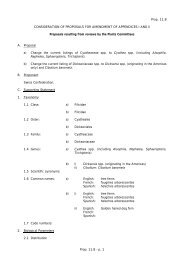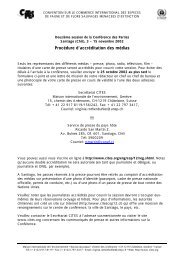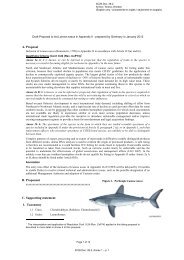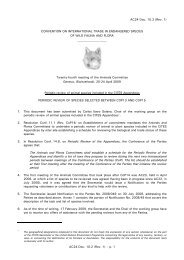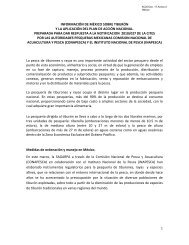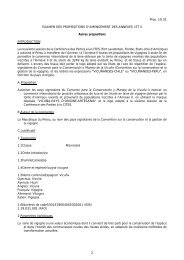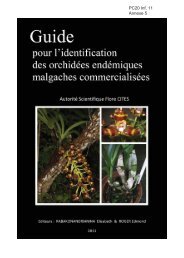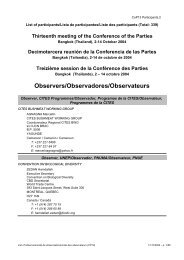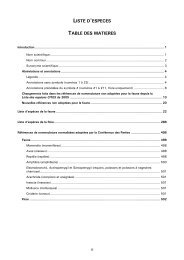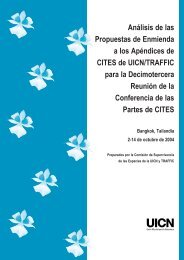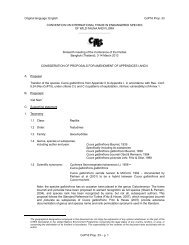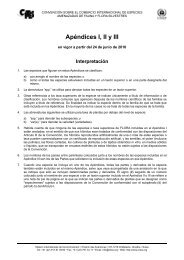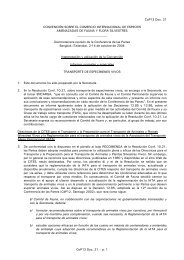Review of CITES Appendixes Based on Resolution Conf. 9.24 (Rev.)
Review of CITES Appendixes Based on Resolution Conf. 9.24 (Rev.)
Review of CITES Appendixes Based on Resolution Conf. 9.24 (Rev.)
Create successful ePaper yourself
Turn your PDF publications into a flip-book with our unique Google optimized e-Paper software.
AC17 Inf. 6<br />
(English and Spanish <strong>on</strong>ly/ Seulement en anglais et espagnol)<br />
<str<strong>on</strong>g><strong>Rev</strong>iew</str<strong>on</strong>g> <str<strong>on</strong>g>of</str<strong>on</strong>g> <str<strong>on</strong>g>CITES</str<strong>on</strong>g> <str<strong>on</strong>g>Appendixes</str<strong>on</strong>g><br />
<str<strong>on</strong>g>Based</str<strong>on</strong>g> <strong>on</strong> Resoluti<strong>on</strong> C<strong>on</strong>f. <strong>9.24</strong> (<strong>Rev</strong>.)<br />
Totoaba macd<strong>on</strong>aldi (Mexican seabass)<br />
Prepared by Scientific Authority <str<strong>on</strong>g>CITES</str<strong>on</strong>g> Mexico<br />
1.Tax<strong>on</strong>omy<br />
1.1 Class Osteichthyes<br />
1.2 Order Perciformes<br />
1.3 Family Sciaenidae<br />
1.4 Genus, Species or Subspecies, Including Author and Year.<br />
Totoaba macd<strong>on</strong>aldi (Gilbert)<br />
1.5 Scientific syn<strong>on</strong>yms<br />
Cynoci<strong>on</strong> macd<strong>on</strong>aldi (Gilbert 1891)<br />
1.6 Comm<strong>on</strong> names<br />
They are several comm<strong>on</strong> names used to identify this species in the literature end <str<strong>on</strong>g>of</str<strong>on</strong>g> comm<strong>on</strong><br />
speech<br />
In English:<br />
In Spanish:<br />
Mexican seabass<br />
Cabicucho<br />
Tutuaba<br />
Curvineta<br />
mexican weakfish<br />
Curvina piedrera<br />
jewfish.<br />
Abanico<br />
Machorro<br />
Although it is important to say that fishermen change names from <strong>on</strong>e fishing seas<strong>on</strong> to<br />
another, so they d<strong>on</strong>'t get caught, and avoid being imposed a sancti<strong>on</strong>. In general when small<br />
Totoaba are caught they are sold filled as "Cabicucho or Corvina", and when large fish are<br />
caught are caught they are sold mainly as grouper.<br />
1.7 number and codes referred in <str<strong>on</strong>g>CITES</str<strong>on</strong>g><br />
This species is listed an appendix I, but has no assigned code.<br />
2. Biological parameters<br />
2.1 Distributi<strong>on</strong><br />
The original distributi<strong>on</strong> for this species (Totoaba macd<strong>on</strong>aldi) originated from the Colorado<br />
River mouth down to "Bahía C<strong>on</strong>cepción" ,<strong>on</strong> the Peninsula Coast <str<strong>on</strong>g>of</str<strong>on</strong>g> the Sea <str<strong>on</strong>g>of</str<strong>on</strong>g> Cortez, and<br />
from the same River mouth down to the river known as "Rio Fuerte" in the state <str<strong>on</strong>g>of</str<strong>on</strong>g> Sinaloa<br />
(<strong>on</strong> the C<strong>on</strong>tinental Coast) (Berdegue 1955). Totoaba, has a characteristic migrati<strong>on</strong> pattern,<br />
it's known that during the winter seas<strong>on</strong> the reproductive populati<strong>on</strong> occupy deep waters<br />
around the big islands in the Golf (Angel de la Guarda and Isla Tibur<strong>on</strong>) (Arvizu y Chavez<br />
1972, Flanagan y Hendricks<strong>on</strong> 1976, Barrea-Guevara 1990) and during early spring they<br />
migrate north to the area known as the Colorado River Delta where they spawn during April<br />
AC17 Inf. 6 – p. 1
and May (Berdegue 1955). The Delta area <str<strong>on</strong>g>of</str<strong>on</strong>g> the high Sea <str<strong>on</strong>g>of</str<strong>on</strong>g> Cortez is c<strong>on</strong>sidered the nursery<br />
and refuge for the early life stages and juveniles, and it has been designated as the "The<br />
biosphere reserve <str<strong>on</strong>g>of</str<strong>on</strong>g> the high Sea <str<strong>on</strong>g>of</str<strong>on</strong>g> Cortez and a Colorado River Delta", mainly to protect<br />
endemic an endangered species like Totoaba and the Vaquita (Diario Oficial de la Federación<br />
1993). Juvenile Totoaba remain in this nursery habitat two or three years before they join the<br />
reproductive populati<strong>on</strong> and migrate south during winter (Flanagan y Hendricks<strong>on</strong> 1976). The<br />
most recent distributi<strong>on</strong> for this species based <strong>on</strong> accidental fishery observati<strong>on</strong>s, is that the<br />
South limit corresp<strong>on</strong>ds to the big islands and the North limit <str<strong>on</strong>g>of</str<strong>on</strong>g> the distributi<strong>on</strong> to the<br />
Colorado Delta area in the high Sea <str<strong>on</strong>g>of</str<strong>on</strong>g> Cortez.<br />
It's from this informati<strong>on</strong> that we can understand that the populati<strong>on</strong> is divided into two large<br />
groups, <strong>on</strong>e that corresp<strong>on</strong>ds to a breeding subpopulati<strong>on</strong> that occupy the southern limit <str<strong>on</strong>g>of</str<strong>on</strong>g><br />
distributi<strong>on</strong>, and another subgrouping composed by larval and juvenile stages that live in the<br />
North limit in the nursery grounds.<br />
2.2 Available habitat<br />
Today we can c<strong>on</strong>sider that the distributi<strong>on</strong> range for Totoaba has been c<strong>on</strong>siderably reduced,<br />
because the southern limit has moved North to a latitude close to the big islands. It should<br />
also be taken into c<strong>on</strong>siderati<strong>on</strong> that during the past century the high Sea <str<strong>on</strong>g>of</str<strong>on</strong>g> Cortez has<br />
suffered pr<str<strong>on</strong>g>of</str<strong>on</strong>g>ound modificati<strong>on</strong>s to its hydrological c<strong>on</strong>diti<strong>on</strong>. Only between 1910-1920 the<br />
mean discharge from the Colorado River was around 21.4x10 9 m 3 /year, and by after 1952<br />
the water flow from the Colorado River to the Delta had diminished to <strong>on</strong>ly 0.8x10 9 m 3 /year<br />
because <str<strong>on</strong>g>of</str<strong>on</strong>g> the c<strong>on</strong>structi<strong>on</strong> <str<strong>on</strong>g>of</str<strong>on</strong>g> the Hoover Dam in 1934, and the Glen Cany<strong>on</strong> Dam in 1952,<br />
so after the c<strong>on</strong>structi<strong>on</strong> the flow <strong>on</strong>ly represents 4% <str<strong>on</strong>g>of</str<strong>on</strong>g> the mean discharge between 1910-<br />
1920 (Carbajal, et al., 1997). This reducti<strong>on</strong> in the freshwater River flow has in c<strong>on</strong>sequence<br />
drastically modified the hydrology <str<strong>on</strong>g>of</str<strong>on</strong>g> the Colorado River Delta, it's changed from a normal<br />
estuary envir<strong>on</strong>ment (0 ppt salinity at the head <str<strong>on</strong>g>of</str<strong>on</strong>g> the estuary to 20 ppt salinity at the Delta)<br />
to reverse estuary c<strong>on</strong>diti<strong>on</strong> that generates saltwater (with amenities that increase towards<br />
the Delta) (Carbajal, et al., 1997). The salinity <str<strong>on</strong>g>of</str<strong>on</strong>g> this area is no l<strong>on</strong>ger affected by a<br />
significant outflow <str<strong>on</strong>g>of</str<strong>on</strong>g> freshwater from the Colorado and it normally averages around 35-37<br />
ppt due to the evaporati<strong>on</strong> caused by the dry and warm climate <str<strong>on</strong>g>of</str<strong>on</strong>g> this regi<strong>on</strong> (Barrera-<br />
Guevara, 1990; Carbajal, et al., 1997; Hernández-Ayón, et al., 1993). Normal estuary<br />
c<strong>on</strong>diti<strong>on</strong>s <strong>on</strong>ly appear during years with a very high rainfall.<br />
The negative impact <strong>on</strong> the Totoaba populati<strong>on</strong> due to the diminishment <str<strong>on</strong>g>of</str<strong>on</strong>g> the Colorado River<br />
flow has been questi<strong>on</strong>ed over the years, mainly because after 40 years <str<strong>on</strong>g>of</str<strong>on</strong>g> flow c<strong>on</strong>trol <str<strong>on</strong>g>of</str<strong>on</strong>g><br />
this River this species is still not extinct. However, the present abundance <str<strong>on</strong>g>of</str<strong>on</strong>g> Totoaba should<br />
be c<strong>on</strong>sidered with a historic perspective, because the <strong>on</strong>ly data available for this species<br />
corresp<strong>on</strong>ds to the fishery data which can <strong>on</strong>ly give us an idea <str<strong>on</strong>g>of</str<strong>on</strong>g> the relative abundance<br />
during the time the fishery was established, and will never be possible to have an historic<br />
estimate <str<strong>on</strong>g>of</str<strong>on</strong>g> the populati<strong>on</strong> size (Cisneros-Mata 1995). During the early 1900s large adult<br />
Totoaba were so abundant in the high Sea <str<strong>on</strong>g>of</str<strong>on</strong>g> Cortez that it was possible to spearfish them<br />
(Berdegue 1955). The commercial fishery reached its maximum in the early 1940s and<br />
declined from there <strong>on</strong>, and the flow from the Colorado River diminished significantly during<br />
the mid-1930s, and although this cannot be c<strong>on</strong>sidered strictly as a direct cause -- effect, the<br />
possibility that the Colorado River flow c<strong>on</strong>trol had an adverse or negative impact <strong>on</strong> the<br />
Totoaba populati<strong>on</strong> should be c<strong>on</strong>sidered (Cisneros-Mata et.al 1995). It's suggested that<br />
actual abundance, is much lower than in the past, for it was required to fish during two<br />
m<strong>on</strong>ths to capture 11 broodstock to start a captive breeding program (True et al 1997). It has<br />
also been shown under laboratory c<strong>on</strong>diti<strong>on</strong>s that <strong>on</strong>e-year-old juvenile Totoaba have a lesser<br />
metabolical expenditure at salinities around 20 ppt (Ortiz-Viveros 1999), which could intern<br />
indicate that the c<strong>on</strong>trol <str<strong>on</strong>g>of</str<strong>on</strong>g> the Colorado River could have significant c<strong>on</strong>sequences <strong>on</strong> the<br />
biology <str<strong>on</strong>g>of</str<strong>on</strong>g> this animal.<br />
AC17 Inf. 6 – p. 2
2.3. Status <str<strong>on</strong>g>of</str<strong>on</strong>g> the populati<strong>on</strong><br />
To date, after the 1975 moratorium, there has not been a new census, we <strong>on</strong>ly have the<br />
historical data <str<strong>on</strong>g>of</str<strong>on</strong>g> the Totoaba fishery. The fishery started during the late 1920s, and piqued<br />
with a record <str<strong>on</strong>g>of</str<strong>on</strong>g> 2,000 t<strong>on</strong>s in 1943, and from there <strong>on</strong> the captures diminished to <strong>on</strong>ly 50<br />
t<strong>on</strong>s in 1975 (FH). It was this year that a total moratorium was imposed <strong>on</strong> this resource.<br />
Cinsneros-Mata et.al (1995) have estimated that the accidental capture <str<strong>on</strong>g>of</str<strong>on</strong>g> juvenile Totoaba<br />
by the shrimp fishery is around 120,834/year and that poaching <str<strong>on</strong>g>of</str<strong>on</strong>g> Totoaba broodstock was<br />
around 6,218 in the mid-80s. The previous indicates that the Totoaba populati<strong>on</strong> is president,<br />
but there's no estimate <str<strong>on</strong>g>of</str<strong>on</strong>g> its size. Rosales-Juarez y Ramirez-G<strong>on</strong>zalez (1987) have suggested<br />
a slight recuperati<strong>on</strong> <str<strong>on</strong>g>of</str<strong>on</strong>g> the natural populati<strong>on</strong>, and Roman-Rodriguez (1994), has studied the<br />
aged structure <str<strong>on</strong>g>of</str<strong>on</strong>g> the natural populati<strong>on</strong> with otoliths, c<strong>on</strong>cluding that the aged structure<br />
appears to be normal, but it should be taken into account that there is a block <str<strong>on</strong>g>of</str<strong>on</strong>g> informati<strong>on</strong><br />
missing for organisms three to five years <str<strong>on</strong>g>of</str<strong>on</strong>g> age. From the prior informati<strong>on</strong> we must<br />
understand that there is no real estimate <str<strong>on</strong>g>of</str<strong>on</strong>g> the current size <str<strong>on</strong>g>of</str<strong>on</strong>g> the Totoaba populati<strong>on</strong>, and<br />
although commentary and rumors am<strong>on</strong>g the fishermen about accidental catching is <strong>on</strong> the<br />
rise, there's no evidence that there sufficiently high to support a fishery.<br />
2.4 Populati<strong>on</strong> trends<br />
There is no quantitative informati<strong>on</strong> in trends that shows that the populati<strong>on</strong> is healthy,<br />
however, fishermen have noticed that the Totoaba’s populati<strong>on</strong> is worst than five years ago.<br />
2.5 Geographical tendencies<br />
It’s habitat have had a lot <str<strong>on</strong>g>of</str<strong>on</strong>g> changes and several damages due to the eliminati<strong>on</strong> <str<strong>on</strong>g>of</str<strong>on</strong>g> the<br />
freshwater flow from the Colorado River since the 1960s and has caused an increase in<br />
salinity changing from an estuarine envir<strong>on</strong>ment into the evaporati<strong>on</strong> basin with salinities<br />
higher than seawater near Río Colorado Delta (Flanagan & Hendricks<strong>on</strong> 1976).<br />
2.6 Species functi<strong>on</strong> in the ecosystem<br />
Totoaba, is a high-level predator in the food chain in the Sea <str<strong>on</strong>g>of</str<strong>on</strong>g> Cortés. Broodstock and<br />
preadults feed primarily <strong>on</strong> crab and sardines (Roman-Rodrigues 1990). The relati<strong>on</strong> between<br />
Totoaba and Vaquita (Phocoena sinus) has been documented in literature in many different<br />
ways, the fact is that the Vaquita was caught in the Totoaba nets (Brownell 1983, Vidal<br />
1995), and it's possible that these species could share the same food source, mainly small<br />
finish, squid and crustaceans (Roman-Rodrigues 1990,Brownell 1982). The early life stages<br />
<str<strong>on</strong>g>of</str<strong>on</strong>g> Totoaba (larval and juveniles) depend primarily <strong>on</strong> the productivity (primary and sec<strong>on</strong>dary)<br />
that takes place in the high Sea <str<strong>on</strong>g>of</str<strong>on</strong>g> Cortez, their survival is directly linked to the carrying<br />
capacity <str<strong>on</strong>g>of</str<strong>on</strong>g> this area.<br />
2.7 reas<strong>on</strong>s to be at risk<br />
The major reas<strong>on</strong>s that Totoaba is currently an endangered species, corresp<strong>on</strong>d to those that<br />
caused its decline: the accidental catching <str<strong>on</strong>g>of</str<strong>on</strong>g> Totoaba juveniles by the shrimp fishery, over<br />
fishing <str<strong>on</strong>g>of</str<strong>on</strong>g> the broodstock populati<strong>on</strong> and alterati<strong>on</strong> to the nursery and reproducti<strong>on</strong> area<br />
caused by the Colorado River flow c<strong>on</strong>trol to the northern Sea <str<strong>on</strong>g>of</str<strong>on</strong>g> Cortez.<br />
Two decades after 1940 the shrimp fishery evolved and because <str<strong>on</strong>g>of</str<strong>on</strong>g> its rapid expansi<strong>on</strong> it was<br />
finally acknowledged that it had a serious impact <strong>on</strong> Totoaba (Bergague 1955), primarily<br />
because juvenile Totoaba were caught by the trawl nets <str<strong>on</strong>g>of</str<strong>on</strong>g> the shrimping boats in the area <str<strong>on</strong>g>of</str<strong>on</strong>g><br />
the northern Sea <str<strong>on</strong>g>of</str<strong>on</strong>g> Cortez. As time progressed the Totoaba and the shrimp fisheries turned<br />
AC17 Inf. 6 – p. 3
into complementary activities for the fishermen (Avalos-Hernandez 1974), and a unknown<br />
number <str<strong>on</strong>g>of</str<strong>on</strong>g> fishermen divided their activities, fishing from October to December Shrimp and<br />
from January to March Totoaba. This way <str<strong>on</strong>g>of</str<strong>on</strong>g> working, switching from <strong>on</strong>e resource to<br />
another is true today, fishermen still dedicated their effort towards fishing several different<br />
species that are abundant in the high Sea <str<strong>on</strong>g>of</str<strong>on</strong>g> Cortés, and although there is a restricted access<br />
to the biosphere reserve <str<strong>on</strong>g>of</str<strong>on</strong>g> the high Sea <str<strong>on</strong>g>of</str<strong>on</strong>g> Cortez and Colorado River Delta, enforcement is<br />
not enough to maintain c<strong>on</strong>trol over the shrimp fishing industry and sport fishing.<br />
The fishery for adult Totoaba was a very important activity because <str<strong>on</strong>g>of</str<strong>on</strong>g> the high price that the<br />
Oriental market <str<strong>on</strong>g>of</str<strong>on</strong>g>fered for the dried swim bladder "BUCHE", which commanded $5/lb in early<br />
'50s (Berdegué 1955), this made the fishermen to develop better ways to capture Totoaba,<br />
this was at this time that the gillnet called "Totoababera" was developed, it was a cott<strong>on</strong> 8<br />
to 10 in. mesh gill net. Although there has been a moratorium <strong>on</strong> Totoaba fishing since 1975,<br />
poaching for this species store exists, Cisneros-Mata et.al (1995) estimate that in the mid-<br />
1980s the legal take was 6218 finish or 161.7 metric t<strong>on</strong>s, and although currently there is no<br />
estimate <str<strong>on</strong>g>of</str<strong>on</strong>g> the illegal fishing, there are reports <str<strong>on</strong>g>of</str<strong>on</strong>g> several c<strong>on</strong>fiscati<strong>on</strong>s <str<strong>on</strong>g>of</str<strong>on</strong>g> Totoaba by<br />
PROFEPA, which indicates that there still is a black market for this species.<br />
The pr<str<strong>on</strong>g>of</str<strong>on</strong>g>ound hydrographical changes in the high Sea <str<strong>on</strong>g>of</str<strong>on</strong>g> Cortez caused by the c<strong>on</strong>structi<strong>on</strong> <str<strong>on</strong>g>of</str<strong>on</strong>g><br />
the dams in Southern California, has not been evaluated to its full extent. But it's clear that<br />
today's c<strong>on</strong>diti<strong>on</strong>s are very different from those that were present in the 1930s, the<br />
eliminati<strong>on</strong> <str<strong>on</strong>g>of</str<strong>on</strong>g> the freshwater flow from the Colorado River by the 1960s has caused an<br />
increase in salinity and changed from an estuarine envir<strong>on</strong>ment into the evaporati<strong>on</strong> basin<br />
with salinities higher than seawater (Flanagan & Hendricks<strong>on</strong> 1976). This change with no<br />
doubt has caused an impact and detriment to the envir<strong>on</strong>ment were the Totoaba reproduce<br />
and develop. A laboratory study with <strong>on</strong>e-year-old Totoaba juveniles acclimated to different<br />
salinities determined that the metabolical expenditure was lowest at 20ppt (Ortiz-Viveros,<br />
1999) which could suggest that this species is adapted to an estuarine envir<strong>on</strong>ment.<br />
3. Uses and trade<br />
3.1 Nati<strong>on</strong>al use<br />
There's no legal commerce <str<strong>on</strong>g>of</str<strong>on</strong>g> this species since 1975, however, it’s know that due to<br />
demand <str<strong>on</strong>g>of</str<strong>on</strong>g> fish’s swim bladder and the difficulty to identify the specie, are high probabilities<br />
to find Totoaba’s swim bladder in the market.<br />
3.2 Captive breeding or artificial reproducti<strong>on</strong> related to trade<br />
Due to foreinger’s demand is just for swim bladder, the rest <str<strong>on</strong>g>of</str<strong>on</strong>g> Totoaba’s body is sell in the<br />
nati<strong>on</strong>al market, majority en the northwest <str<strong>on</strong>g>of</str<strong>on</strong>g> Mexico.<br />
4. C<strong>on</strong>servati<strong>on</strong><br />
4.1 Species management<br />
4.1.1 Species supervisi<strong>on</strong><br />
As a first measure for protecti<strong>on</strong> <str<strong>on</strong>g>of</str<strong>on</strong>g> this species in 1974 the Mexican government established<br />
a reserve area to prohibit the fishing activities primarily by shrimping boats in the Colorado<br />
Delta area. In order to reduce the trade/commerce <str<strong>on</strong>g>of</str<strong>on</strong>g> Totoaba, in 1975 the Mexican<br />
government established a permanent moratorium <strong>on</strong> Totoaba fishing and 1976 it was added<br />
to the list <str<strong>on</strong>g>of</str<strong>on</strong>g> species in <str<strong>on</strong>g>CITES</str<strong>on</strong>g>, and in 1979 it was also added to the list <str<strong>on</strong>g>of</str<strong>on</strong>g> endangered<br />
AC17 Inf. 6 – p. 4
species <str<strong>on</strong>g>of</str<strong>on</strong>g> the United States, federal registry 44 (99) (Barrera-Guevara, 1990). As an<br />
additi<strong>on</strong>al measure in 1993 the Mexican government decreed the biosphere reserve "high Sea<br />
<str<strong>on</strong>g>of</str<strong>on</strong>g> Cortez and Colorado River Delta" (Diario Oficial de la Federaci<strong>on</strong> 1993), with the objective<br />
to promote research, protecti<strong>on</strong> and sustainable use <str<strong>on</strong>g>of</str<strong>on</strong>g> the biodiversity and natural resources<br />
<str<strong>on</strong>g>of</str<strong>on</strong>g> the regi<strong>on</strong>, based primarily <strong>on</strong> the protecti<strong>on</strong> <str<strong>on</strong>g>of</str<strong>on</strong>g> endemic species like: Totoaba and Vaquita.<br />
4.1.2 Habitat c<strong>on</strong>servati<strong>on</strong><br />
Together with the decreeing <str<strong>on</strong>g>of</str<strong>on</strong>g> the biosphere reserve "high Sea <str<strong>on</strong>g>of</str<strong>on</strong>g> Cortez and Colorado were<br />
Delta" there is a management plan for such reserve, put together by a interinstituti<strong>on</strong>al group<br />
with the intenti<strong>on</strong> to establish different measures for habitat c<strong>on</strong>servati<strong>on</strong> and species that<br />
live in it, participants are primarily the different levels <str<strong>on</strong>g>of</str<strong>on</strong>g> government and research institutes<br />
<str<strong>on</strong>g>of</str<strong>on</strong>g> both the S<strong>on</strong>ora and Baja California states.<br />
4.1.3 Management measures<br />
During the past several years a captive breeding program for this species has been initiated.<br />
Starting in 1995 an initial group <str<strong>on</strong>g>of</str<strong>on</strong>g> 11 broodstock were caught and transported to the<br />
installati<strong>on</strong>s <str<strong>on</strong>g>of</str<strong>on</strong>g> the Aut<strong>on</strong>omous University <str<strong>on</strong>g>of</str<strong>on</strong>g> Baja California, in which a field technique was<br />
developed to solve the decompressi<strong>on</strong> <str<strong>on</strong>g>of</str<strong>on</strong>g> this species at capture (True et. al 1997). In the<br />
following years proper methods for maturing, spawning and reproducti<strong>on</strong> in captivity have<br />
been developed (That et. al. 2001). Also for the first time the early life history <str<strong>on</strong>g>of</str<strong>on</strong>g> the species<br />
it has been described, both for the embryo and larval development, with emphasis <strong>on</strong> feeding<br />
and development <strong>on</strong> to four-m<strong>on</strong>th old juveniles (Morales-Ortiz 1999, Sandoval-Garibaldi et.al<br />
2001). To understand the physiological capacities <str<strong>on</strong>g>of</str<strong>on</strong>g> Totoaba and fine-tune aquaculture<br />
procedures several experiments have been d<strong>on</strong>e; Ortiz-Viveros (1999) described the tolerance<br />
and effect <str<strong>on</strong>g>of</str<strong>on</strong>g> acclimati<strong>on</strong> <str<strong>on</strong>g>of</str<strong>on</strong>g> Totoaba juveniles to different salinities, Jacome-Ibarra (2000)<br />
evaluated the effect <str<strong>on</strong>g>of</str<strong>on</strong>g> sustained exercise as a measure <str<strong>on</strong>g>of</str<strong>on</strong>g> energy expenditure under<br />
laboratory c<strong>on</strong>diti<strong>on</strong>s, Talamas-Rohana et.al (2001)a,b. Studied the thermal preferendum <str<strong>on</strong>g>of</str<strong>on</strong>g><br />
acclimated Totoaba juveniles to different temperatures and also evaluated their energy budget<br />
with three m<strong>on</strong>ths old Totoaba juveniles acclimated to different temperatures, also<br />
Altamirano-Garcia y Lopez (2001) have evaluated the use <str<strong>on</strong>g>of</str<strong>on</strong>g> commercial feed with relati<strong>on</strong> to<br />
growth and biochemical compositi<strong>on</strong> with <strong>on</strong>e-year-old juvenile Totoaba.<br />
To date it has been possible to c<strong>on</strong>struct a 400 square meter state-<str<strong>on</strong>g>of</str<strong>on</strong>g>-the-art facility,<br />
dedicated to develop culture protocols for this species (True 1999). As a result, a pilot<br />
program to start repopulati<strong>on</strong> <str<strong>on</strong>g>of</str<strong>on</strong>g> this species was initiated, and to date it has released a total<br />
<str<strong>on</strong>g>of</str<strong>on</strong>g> 2250 eight-m<strong>on</strong>th-old juvenile Totoaba, with the final objective <str<strong>on</strong>g>of</str<strong>on</strong>g> releasing 10,000<br />
juveniles per year by the end <str<strong>on</strong>g>of</str<strong>on</strong>g> 2002 (True 2000).<br />
4.2 Measures <str<strong>on</strong>g>of</str<strong>on</strong>g> c<strong>on</strong>trol<br />
4.2.1 internati<strong>on</strong>al trade<br />
This species is regulated by C<strong>on</strong>venti<strong>on</strong> <strong>on</strong> Internati<strong>on</strong>al Trade in Endangered Species <str<strong>on</strong>g>of</str<strong>on</strong>g> Wild<br />
Fauna and Flora, it’s listed in Appendix I <str<strong>on</strong>g>of</str<strong>on</strong>g> <str<strong>on</strong>g>CITES</str<strong>on</strong>g><br />
4.2.2 Nati<strong>on</strong>al measures<br />
Totoaba macd<strong>on</strong>aldi is protected by NOM-ECOL-059-94 ranked as endangered <str<strong>on</strong>g>of</str<strong>on</strong>g> extincti<strong>on</strong>.<br />
Although, in Mexico exists a presidential act that prohibit any kind <str<strong>on</strong>g>of</str<strong>on</strong>g> Totoaba’s capture<br />
during any seas<strong>on</strong> <str<strong>on</strong>g>of</str<strong>on</strong>g> the year.<br />
AC17 Inf. 6 – p. 5
5. Informati<strong>on</strong> <strong>on</strong> similar species<br />
This species can be sold as fillet, under the syn<strong>on</strong>yms <str<strong>on</strong>g>of</str<strong>on</strong>g> "corvina", "cabicucho" and some<br />
times as grouper.<br />
The Oriental market for dry seafood is very important, fish swim bladders known as belly or<br />
fish Maw commands very high prices, as high as $120/kg for premium quality and $40/kg <str<strong>on</strong>g>of</str<strong>on</strong>g><br />
lesser quality ((Shawneen & D<strong>on</strong>g., 1998, Richm<strong>on</strong>d Ltd, 1997)). Because it is very difficult<br />
or almost impossible to identify the species or source <str<strong>on</strong>g>of</str<strong>on</strong>g> the swim bladders it's very likely that<br />
Totoaba swim bladder "BUCHE" could be <strong>on</strong> the market, it should be noted that the Totoaba<br />
swim bladder is <str<strong>on</strong>g>of</str<strong>on</strong>g> the highest quality, and that other species related to Totoaba such as<br />
(Cynosci<strong>on</strong> phoxocephalus) have prices around $80/kg and that it <strong>on</strong>ly takes two broodstock<br />
fish to obtain a kilogram <str<strong>on</strong>g>of</str<strong>on</strong>g> swim bladder.<br />
As a measure that could be adopted to distinguish between Totoaba and similar species, it<br />
would be an advantage to develop genetic markers that can be applied in the field and<br />
identify Totoaba flesh and swim bladders from others. On the other hand, a photo graphical<br />
catalog with emphasis <strong>on</strong> the different presentati<strong>on</strong>s <str<strong>on</strong>g>of</str<strong>on</strong>g> similar species (primarily others<br />
Sciaenids) like; fresh fillet <strong>on</strong> ice, fresh frozen fillet, cubed or diced presentati<strong>on</strong> <strong>on</strong> ice, cubed<br />
or diced presentati<strong>on</strong> <strong>on</strong> ice and the whole fish without head and fins, could help as a visual<br />
aid during inspecti<strong>on</strong> <str<strong>on</strong>g>of</str<strong>on</strong>g> seafood shipments by the required agencies where documentati<strong>on</strong> or<br />
revisi<strong>on</strong> <str<strong>on</strong>g>of</str<strong>on</strong>g> <str<strong>on</strong>g>of</str<strong>on</strong>g> such shipments occur (port landings, internati<strong>on</strong>al fr<strong>on</strong>tiers, open bid markets).<br />
6. Complementary observati<strong>on</strong>s<br />
A study to compare and evaluate the genetic variability <str<strong>on</strong>g>of</str<strong>on</strong>g> Totoaba raised in captivity vs. the<br />
natural populati<strong>on</strong> has started, with the main objective to determine the possible impact<br />
caused by the release <str<strong>on</strong>g>of</str<strong>on</strong>g> large numbers <str<strong>on</strong>g>of</str<strong>on</strong>g> fish reproduced from a small captive breeding<br />
populati<strong>on</strong> (De la Rosa 2000).<br />
In summary, because <str<strong>on</strong>g>of</str<strong>on</strong>g> the unique characteristics <str<strong>on</strong>g>of</str<strong>on</strong>g> this species, being endemic and also the<br />
largest member <str<strong>on</strong>g>of</str<strong>on</strong>g> the family, c<strong>on</strong>sidering its habitat modificati<strong>on</strong>s mainly due to the change<br />
in the Colorado River flow, the clear fragmentati<strong>on</strong> or natural segregati<strong>on</strong> into two it<br />
distinctive groups (broodstock, early life development and juveniles), the c<strong>on</strong>tinued poaching<br />
<str<strong>on</strong>g>of</str<strong>on</strong>g> this species and the incidental by catch from shrimping industry, the high prices <strong>on</strong> the<br />
internati<strong>on</strong>al market for fish maw (Buche), the difficulty to identify Totoaba flesh and swim<br />
bladders from those <str<strong>on</strong>g>of</str<strong>on</strong>g> other similar fish, and the state <str<strong>on</strong>g>of</str<strong>on</strong>g> development <str<strong>on</strong>g>of</str<strong>on</strong>g> the captive<br />
breeding program; it is recommended that this species remains an appendix I.<br />
Particularly if we c<strong>on</strong>sider that there is no current estimate <str<strong>on</strong>g>of</str<strong>on</strong>g> the natural populati<strong>on</strong> size, and<br />
that the captive breeding program is just starting with its release effort, and it will take<br />
several years before it will be possible to ascertain its c<strong>on</strong>tributi<strong>on</strong>. It should be c<strong>on</strong>sidered<br />
that Totoaba has received important protecti<strong>on</strong> because <str<strong>on</strong>g>of</str<strong>on</strong>g> the appendix I listing, and that it<br />
this protecti<strong>on</strong> should remain until the status <str<strong>on</strong>g>of</str<strong>on</strong>g> the natural populati<strong>on</strong> is established in order<br />
to determine if this species could be subject <strong>on</strong>ce more to trade, c<strong>on</strong>sidering both the fishing<br />
aspect and the possible aquaculture development that will develop from the captive breeding<br />
program.<br />
7. Referencias<br />
Altamirano-García R.I. y López L.M., 2001. Efecto de la dieta en la composición química y<br />
calórica en juveniles de Totoaba macd<strong>on</strong>aldi (Gilbert), cultivados en laboratorio. VIII<br />
AC17 Inf. 6 – p. 6
C<strong>on</strong>greso Naci<strong>on</strong>al y II Simposium Internaci<strong>on</strong>al sobre el Mar de Cortés. Facultad de<br />
Ciencias Marinas, UABC.<br />
Arvizu, J. y Chavez, H. 1972 Sinopsis sobre la biología de la Totoaba (Cynoci<strong>on</strong> macd<strong>on</strong>aldi)<br />
Gilbert, 1890. FAO. Fish Synop. 108: 26pp.<br />
Avalos-Hernández, 1974. Desarrollo Histórico de las Pesquerías del Camarón (Penaeus sp.) y<br />
Totoaba (Cynoci<strong>on</strong> macd<strong>on</strong>aldi) Gilbert, 1890 en la Parte Norte del Golfo de California,<br />
Tesis licenciatura Escuela Superior de Ciencias Marinas U.A.B.C. Ensenada. 45pp.<br />
Barrera-Guevara, J.C. 1990. The c<strong>on</strong>servati<strong>on</strong> <str<strong>on</strong>g>of</str<strong>on</strong>g> Totoaba macd<strong>on</strong>aldi, (Pisces: Scianidae), in<br />
the Gulf <str<strong>on</strong>g>of</str<strong>on</strong>g> California, Mexico. J. Of Fish Bio. 37 (Supplement A): 201-202<br />
Berdegue, A.J. 1955. La pesqueria de Totoaba (Cynosci<strong>on</strong> macd<strong>on</strong>aldi)en San Felipe, Baja<br />
California. <strong>Rev</strong>ista de la Sociedad Mexicana de Historia Natural 16:45-78.<br />
Brownell, R. L., Jr. 1982. Status <str<strong>on</strong>g>of</str<strong>on</strong>g> the cochito, Phocoena sinus in the Gulf <str<strong>on</strong>g>of</str<strong>on</strong>g> California. In<br />
FAO, Advisory Committee <strong>on</strong> Marine Resources Research. Mammals in the Seas: Small<br />
cetaceans, seals, sirenians, and otters. FAO Fish. Ser. 5(4):85-90.<br />
Brownell, R. L., Jr. 1983. Phocoena sinus. Mammalian Species 198:1-3.<br />
Carbajal N., Souza A. Y R. Durazo 1997. A numerical Study <str<strong>on</strong>g>of</str<strong>on</strong>g> the Ex-ROFI <str<strong>on</strong>g>of</str<strong>on</strong>g> the Colorado<br />
River. Journal <str<strong>on</strong>g>of</str<strong>on</strong>g> Marine Systems., 12:17-33.<br />
Cisneros-Mata, M.A., G. M<strong>on</strong>temayor-Lopez, and M.J. Roman- Rodriquez, 1995. Life history<br />
and c<strong>on</strong>servati<strong>on</strong> <str<strong>on</strong>g>of</str<strong>on</strong>g> Totoaba macd<strong>on</strong>aldi. C<strong>on</strong>servati<strong>on</strong> Biology, 9(4): 806-814.<br />
Diario Oficial de la Federación, 1993 Decreto por el que se declara área natural protegida c<strong>on</strong><br />
carácter de Reserva de la Biosfera, la región c<strong>on</strong>ocida como Alto Golfo de California y<br />
Delta del Río Colorado. Artículo Décimo. Tomo CDXXVII No. 8. 24-28.<br />
Flanagan, C.A. and J.R. Hendricks<strong>on</strong>, 1976. Observati<strong>on</strong>s <strong>on</strong> the commercial fishery and<br />
reproductive biology <str<strong>on</strong>g>of</str<strong>on</strong>g> Totoaba, Cynosci<strong>on</strong> macd<strong>on</strong>aldi, in the northern Gulf <str<strong>on</strong>g>of</str<strong>on</strong>g><br />
California. Fishery Bulletin 74:531-544.<br />
Jácome-Ibarra M. y True C.D., 2001. Metabolismo activo como indicador de la aclimatación<br />
al ejercicio sostenido en juveniles de Totoaba macd<strong>on</strong>aldi. VIII C<strong>on</strong>greso Naci<strong>on</strong>al y II<br />
Simposium Internaci<strong>on</strong>al sobre el Mar de Cortés<br />
Morales- Ortiz, Cecilia., 1999. Descripci<strong>on</strong> del desarrollo embri<strong>on</strong>ario de Totoaba (Totoaba<br />
macd<strong>on</strong>aldi) bajo c<strong>on</strong>dici<strong>on</strong>es de laboratorio. Tesis (Licenciatura)--Universidad<br />
Aut<strong>on</strong>oma de Baja California. Facultad de Ciencias Marinas., 55 pp.<br />
Ortiz-Viveros, Daniel 1999. Regulaci<strong>on</strong> i<strong>on</strong>ica y osmotica de los juveniles de Totoaba<br />
macd<strong>on</strong>aldi ante cambios de salinidad / Daniel Ortiz Viveros Tesis Tesis (Maestria)--<br />
Universidad Aut<strong>on</strong>oma de Baja California. Facultad de Ciencias Marinas, Ensenada,<br />
66pp.<br />
Reynolds W.W y A.D. Thomps<strong>on</strong>., 1979. Temperature ans salinity tolerances <str<strong>on</strong>g>of</str<strong>on</strong>g> young Gulf<br />
<str<strong>on</strong>g>of</str<strong>on</strong>g> California Gruni<strong>on</strong>, Leuresthes sardina (Atherrin<str<strong>on</strong>g>of</str<strong>on</strong>g>ormes: Atherinidae). Journal <str<strong>on</strong>g>of</str<strong>on</strong>g><br />
Marine Reserch. 32(I):37-45.<br />
Richm<strong>on</strong>d and Associates Pte Ltd 70, 1997. The Singapore Market for Dried Fish Prepared for<br />
Alaskan Dried Foods November P URL:<br />
http://www.nmfs.noaa.gov/sfweb/sk/salt<strong>on</strong>stallken/singapore.pdf<br />
Roman Rodriguez, M.J., M.G. Hammann, 1997. Age and growth <str<strong>on</strong>g>of</str<strong>on</strong>g> Totoaba, Totoaba<br />
macd<strong>on</strong>aldi (Sciaenidae), in the upper Gulf <str<strong>on</strong>g>of</str<strong>on</strong>g> California. Fishery Bulletin 95:620-628.<br />
Román Rodríguez, M.J., Alimentaci<strong>on</strong> de Totoaba macd<strong>on</strong>aldi (Gilbert) (Piscis: Scieanidae) en<br />
la parte norte del alto golfo de California. Ecologica 1 (2):1-9.<br />
Román Rodríguez, M J., 1994. Edad y crecimiento de la Totoaba (Totoaba macd<strong>on</strong>aldi)<br />
Gilbert en el altoGolfo de California Tesis (Maestro en Ciencias). Centro de<br />
Investigación Científica y de Educación Superior de Ensenada 90 pp<br />
Rosales-Juarez, F., y Ramirez-G<strong>on</strong>zalez, 1987. Estado actual sobre el c<strong>on</strong>ocimiento de la<br />
Totoaba (Cynosci<strong>on</strong> macd<strong>on</strong>aldi Gilbert 1980) Secretaria de Pesca, Mexico.<br />
Sandoval-Garibaldi G., True C.D., Morales C. y Castro-Castro N., 2001. Desarrollo larval de<br />
Totoaba macd<strong>on</strong>aldi (Gilbert). VIII C<strong>on</strong>greso Naci<strong>on</strong>al y II Simposium Internaci<strong>on</strong>al<br />
sobre el Mar de Cortés<br />
AC17 Inf. 6 – p. 7
Shawneen A C<strong>on</strong>over and Yuan fang D<strong>on</strong>g., 1998. H<strong>on</strong>g K<strong>on</strong>g Dried Fish Market The North<br />
Pacific Fisheries Program University <str<strong>on</strong>g>of</str<strong>on</strong>g> Alaska Anchorage for URL:<br />
http://www.nmfs.noaa.gov/sfweb/sk/salt<strong>on</strong>stallken/h<strong>on</strong>gk<strong>on</strong>g.pdf<br />
Talamás-Rohana E., Barón-Sevilla B., Bückle-Ramírez L.F. y True C.D., 2001. Efecto de la<br />
temperatura sobre la preferencia térmica aguda y las temperaturas de evitación de<br />
juveniles de Totoaba macd<strong>on</strong>ladi. VIII C<strong>on</strong>greso Naci<strong>on</strong>al y II Simposium Internaci<strong>on</strong>al<br />
sobre el Mar de Cortés<br />
Talamás-Rohana E., Barón-Sevilla, True C.D. y Bückle-Ramírez L.F., 2001. Efecto de la<br />
temperatura sobre el balance de energía de juveniles de Totoaba macd<strong>on</strong>ladi. VIII<br />
C<strong>on</strong>greso Naci<strong>on</strong>al y II Simposium Internaci<strong>on</strong>al sobre el Mar de Cortés<br />
True C. D., A. S. Loera, and N. C. Castro 1997. Acquisiti<strong>on</strong> <str<strong>on</strong>g>of</str<strong>on</strong>g> Broodstock <str<strong>on</strong>g>of</str<strong>on</strong>g> Totoaba<br />
macd<strong>on</strong>aldi: Field Handling, Decompressi<strong>on</strong>, and Prophylaxis <str<strong>on</strong>g>of</str<strong>on</strong>g> an Endangered<br />
Species. Progresive Fish Culturist # 59: Pages 246-248<br />
True C.D., Castro-Castro N., Sandoval-Garibaldi G. y Moralez-Ortiz C., 2001. Reproducción<br />
c<strong>on</strong>trolada de Totoaba macd<strong>on</strong>aldi(Gilbert). VIII C<strong>on</strong>greso Naci<strong>on</strong>al y II Simposium<br />
Internaci<strong>on</strong>al sobre el Mar de Cortés<br />
True C.D., 2000. Informe anual de Proyecto “Programa Piloto de Repoblamiento de Totoaba<br />
"Una especie en peligro de extinción" Clave A-1-99 20, al F<strong>on</strong>do Mexicano para la<br />
C<strong>on</strong>servaci<strong>on</strong> de la naturaleza.<br />
True C.D., 1999. Informe Final a la SEP, del Apoyo Preseidencial “Ac<strong>on</strong>dici<strong>on</strong>amiento y<br />
adecuación de la infraestructura física y equipamiento para la "Unidad de biotecnología<br />
en Piscicultura", para la producción de alevines de Totoaba.<br />
AC17 Inf. 6 – p. 8
AC17 Inf. 6 – p. 9<br />
Criteria<br />
A<br />
The wild populati<strong>on</strong><br />
is small, and is<br />
characterized by at<br />
least <strong>on</strong>e <str<strong>on</strong>g>of</str<strong>on</strong>g> the<br />
following (i-v):<br />
B<br />
The wild populati<strong>on</strong><br />
has a restricted area<br />
<str<strong>on</strong>g>of</str<strong>on</strong>g> distributi<strong>on</strong> and is<br />
characterized by at<br />
least <strong>on</strong>e <str<strong>on</strong>g>of</str<strong>on</strong>g> the<br />
following (i-iv):<br />
Part I: Appendix I criteria<br />
C<br />
D<br />
A decline in<br />
the number<br />
<str<strong>on</strong>g>of</str<strong>on</strong>g> individuals<br />
in the wild,<br />
which has<br />
been either (iii):<br />
If not<br />
included in AI<br />
species<br />
would satisfy<br />
A, B or C<br />
within five<br />
years<br />
Trade criteria<br />
At least <strong>on</strong>e <str<strong>on</strong>g>of</str<strong>on</strong>g><br />
the following (iiv):<br />
Appendix I<br />
(Y/N)<br />
Tax<strong>on</strong><br />
i ii Iii iv v I Ii iii Iv i ii i ii iii iv<br />
Y Y Y N Y Y Y N Y Y Y Y N2 Y Y Y Y<br />
Totoaba<br />
macd<strong>on</strong>aldi<br />
Key: Y tax<strong>on</strong> satisfies the criteria<br />
N1 tax<strong>on</strong> does not meet the criteria: sufficient informati<strong>on</strong><br />
N2 tax<strong>on</strong> does not meet the criteria: insufficient informati<strong>on</strong><br />
N3 tax<strong>on</strong> does not meet the criteria: no informati<strong>on</strong><br />
Doc. AC. 16.8<br />
Applicati<strong>on</strong><br />
problems<br />
Appendix-I biological criteria<br />
A. The wild populati<strong>on</strong> is small, and is characterized by at least <strong>on</strong>e <str<strong>on</strong>g>of</str<strong>on</strong>g> the following:<br />
i) an observed, inferred or projected decline in the number <str<strong>on</strong>g>of</str<strong>on</strong>g> individuals or the area and quality <str<strong>on</strong>g>of</str<strong>on</strong>g> habitat; or<br />
ii) each sub-populati<strong>on</strong> being very small; or<br />
iii) a majority <str<strong>on</strong>g>of</str<strong>on</strong>g> individuals, during <strong>on</strong>e or more life-history phases, being c<strong>on</strong>centrated in <strong>on</strong>e sub-populati<strong>on</strong>; or<br />
iv) large short-term fluctuati<strong>on</strong>s in the number <str<strong>on</strong>g>of</str<strong>on</strong>g> individuals; or<br />
v) a high vulnerability due to the species' biology or behaviour (including migrati<strong>on</strong>).
B. The wild populati<strong>on</strong> has a restricted area <str<strong>on</strong>g>of</str<strong>on</strong>g> distributi<strong>on</strong> and is characterized<br />
by at least <strong>on</strong>e <str<strong>on</strong>g>of</str<strong>on</strong>g> the following:<br />
i) fragmentati<strong>on</strong> or occurrence at very few locati<strong>on</strong>s; or<br />
ii) large fluctuati<strong>on</strong>s in the area <str<strong>on</strong>g>of</str<strong>on</strong>g> distributi<strong>on</strong> or the number <str<strong>on</strong>g>of</str<strong>on</strong>g> subpopulati<strong>on</strong>s;<br />
or<br />
iii) a high vulnerability due to the species biology or behaviour (including<br />
migrati<strong>on</strong>); or<br />
iv) an observed, inferred or projected decrease in any <strong>on</strong>e <str<strong>on</strong>g>of</str<strong>on</strong>g> the<br />
following:<br />
– the area <str<strong>on</strong>g>of</str<strong>on</strong>g> distributi<strong>on</strong>; or<br />
– the number <str<strong>on</strong>g>of</str<strong>on</strong>g> sub-populati<strong>on</strong>s; or<br />
– the number <str<strong>on</strong>g>of</str<strong>on</strong>g> individuals; or<br />
– the area or quality <str<strong>on</strong>g>of</str<strong>on</strong>g> habitat; or<br />
– reproductive potential.<br />
C. A decline in the number <str<strong>on</strong>g>of</str<strong>on</strong>g> individuals in the wild, which has been either:<br />
i) observed as <strong>on</strong>going or as having occurred in the past (but with a<br />
potential to resume); or<br />
ii) inferred or projected <strong>on</strong> the basis <str<strong>on</strong>g>of</str<strong>on</strong>g> any <strong>on</strong>e <str<strong>on</strong>g>of</str<strong>on</strong>g> the following:<br />
– a decrease in area or quality <str<strong>on</strong>g>of</str<strong>on</strong>g> habitat; or<br />
– levels or patterns <str<strong>on</strong>g>of</str<strong>on</strong>g> exploitati<strong>on</strong>; or<br />
– threats from extrinsic factors such as the effects <str<strong>on</strong>g>of</str<strong>on</strong>g> pathogens,<br />
competitors, parasites, predators, hybridizati<strong>on</strong>, introduced species<br />
and the effects <str<strong>on</strong>g>of</str<strong>on</strong>g> toxins and pollutants; or<br />
– decreasing reproductive potential.<br />
D. The status <str<strong>on</strong>g>of</str<strong>on</strong>g> the species is such that if the species is not included in<br />
Appendix I, it is likely to satisfy <strong>on</strong>e or more <str<strong>on</strong>g>of</str<strong>on</strong>g> the above criteria within a period<br />
<str<strong>on</strong>g>of</str<strong>on</strong>g> five years.<br />
AC17 Inf. 6 – p. 10



